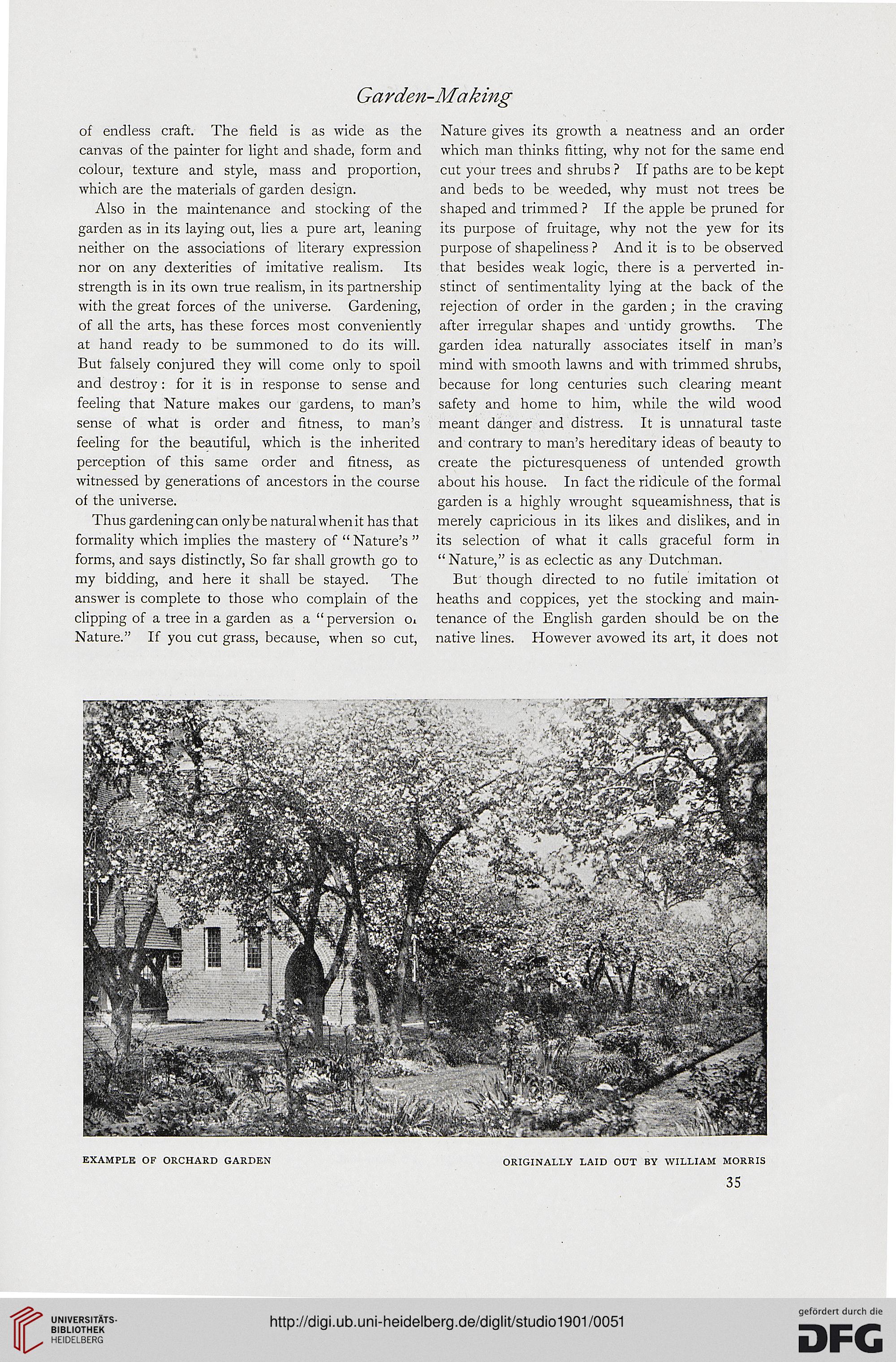Garden-Making
of endless craft. The field is as wide as the
canvas of the painter for light and shade, form and
colour, texture and style, mass and proportion,
which are the materials of garden design.
Also in the maintenance and stocking of the
garden as in its laying out, lies a pure art, leaning
neither on the associations of literary expression
nor on any dexterities of imitative realism. Its
strength is in its own true realism, in its partnership
with the great forces of the universe. Gardening,
of all the arts, has these forces most conveniently
at hand ready to be summoned to do its will.
But falsely conjured they will come only to spoil
and destroy : for it is in response to sense and
feeling that Nature makes our gardens, to man's
sense of what is order and fitness, to man's
feeling for the beautiful, which is the inherited
perception of this same order and fitness, as
witnessed by generations of ancestors in the course
of the universe.
Thus gardening can only be natural when it has that
formality which implies the mastery of " Nature's "
forms, and says distinctly, So far shall growth go to
my bidding, and here it shall be stayed. The
answer is complete to those who complain of the
clipping of a tree in a garden as a " perversion Oi
Nature." If you cut grass, because, when so cut,
Nature gives its growth a neatness and an order
which man thinks fitting, why not for the same end
cut your trees and shrubs ? If paths are to be kept
and beds to be weeded, why must not trees be
shaped and trimmed ? If the apple be pruned for
its purpose of fruitage, why not the yew for its
purpose of shapeliness ? And it is to be observed
that besides weak logic, there is a perverted in-
stinct of sentimentality lying at the back of the
rejection of order in the garden; in the craving
after irregular shapes and untidy growths. The
garden idea naturally associates itself in man's
mind with smooth lawns and with trimmed shrubs,
because for long centuries such clearing meant
safety and home to him, while the wild wood
meant danger and distress. It is unnatural taste
and contrary to man's hereditary ideas of beauty to
create the picturesqueness of untended growth
about his house. In fact the ridicule of the formal
garden is a highly wrought squeamishness, that is
merely capricious in its likes and dislikes, and in
its selection of what it calls graceful form in
"Nature," is as eclectic as any Dutchman.
But though directed to no futile imitation ot
heaths and coppices, yet the stocking and main-
tenance of the English garden should be on the
native lines. However avowed its art, it does not
EXAMPLE OF ORCHARD GARDEN
ORIGINALLY LAID OUT BY WILLIAM MORRIS
35
of endless craft. The field is as wide as the
canvas of the painter for light and shade, form and
colour, texture and style, mass and proportion,
which are the materials of garden design.
Also in the maintenance and stocking of the
garden as in its laying out, lies a pure art, leaning
neither on the associations of literary expression
nor on any dexterities of imitative realism. Its
strength is in its own true realism, in its partnership
with the great forces of the universe. Gardening,
of all the arts, has these forces most conveniently
at hand ready to be summoned to do its will.
But falsely conjured they will come only to spoil
and destroy : for it is in response to sense and
feeling that Nature makes our gardens, to man's
sense of what is order and fitness, to man's
feeling for the beautiful, which is the inherited
perception of this same order and fitness, as
witnessed by generations of ancestors in the course
of the universe.
Thus gardening can only be natural when it has that
formality which implies the mastery of " Nature's "
forms, and says distinctly, So far shall growth go to
my bidding, and here it shall be stayed. The
answer is complete to those who complain of the
clipping of a tree in a garden as a " perversion Oi
Nature." If you cut grass, because, when so cut,
Nature gives its growth a neatness and an order
which man thinks fitting, why not for the same end
cut your trees and shrubs ? If paths are to be kept
and beds to be weeded, why must not trees be
shaped and trimmed ? If the apple be pruned for
its purpose of fruitage, why not the yew for its
purpose of shapeliness ? And it is to be observed
that besides weak logic, there is a perverted in-
stinct of sentimentality lying at the back of the
rejection of order in the garden; in the craving
after irregular shapes and untidy growths. The
garden idea naturally associates itself in man's
mind with smooth lawns and with trimmed shrubs,
because for long centuries such clearing meant
safety and home to him, while the wild wood
meant danger and distress. It is unnatural taste
and contrary to man's hereditary ideas of beauty to
create the picturesqueness of untended growth
about his house. In fact the ridicule of the formal
garden is a highly wrought squeamishness, that is
merely capricious in its likes and dislikes, and in
its selection of what it calls graceful form in
"Nature," is as eclectic as any Dutchman.
But though directed to no futile imitation ot
heaths and coppices, yet the stocking and main-
tenance of the English garden should be on the
native lines. However avowed its art, it does not
EXAMPLE OF ORCHARD GARDEN
ORIGINALLY LAID OUT BY WILLIAM MORRIS
35




